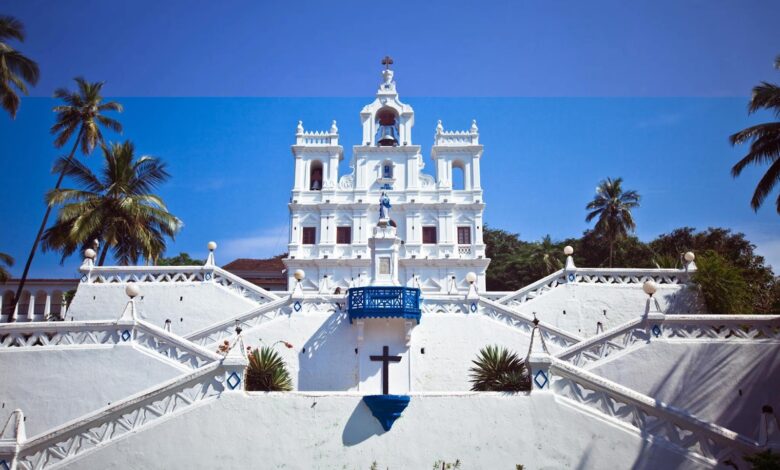Historic Goa: Exploring Centuries-Old Churches and Portuguese Legacy

Goa, known for its sandy beaches and vibrant nightlife, is also steeped in history with a rich Portuguese legacy that is evident in its architecture, culture, and above all, its historic churches.
The state’s history as a Portuguese colony until 1961 is most visible in its old churches, which are not only places of worship but also monuments of great artistic and historical significance.
The Architectural Marvels of Goa’s Churches
Basilica of Bom Jesus: One of the most famous landmarks in Goa, the Basilica of Bom Jesus is renowned for housing the mortal remains of St. Francis Xavier. Recognized as a UNESCO World Heritage Site, this church is a prime example of baroque architecture in India. Its construction was completed in 1605, and it remains an important place of Christian pilgrimage in Asia. The basilica’s non-plastered exterior makes it unique among Goa’s churches. Inside, the marble floor and gilded altars speak volumes of the craftsmanship and artistry that went into its design.
Se Cathedral: Located in Old Goa, just opposite the Basilica of Bom Jesus, Se Cathedral is one of the largest churches in Asia. The cathedral’s construction began in 1562 and took over 90 years to complete. It is famous for its Golden Bell, which is one of the largest in the world and known for its rich tone. The church’s imposing Iberian façade, towering ceilings, and exquisite mosaic work are a testament to the grandeur of Goa’s colonial past.
Church of St. Francis of Assisi: Adjacent to the Se Cathedral, this church was originally built in 1661 by the Portuguese as a chapel but was later expanded into a church. The interior of the church is decorated with scenes from the Bible and features a blend of baroque and Corinthian styles. The church also houses a museum that contains artifacts, sculptures, and paintings depicting the history of the church and the region.
Church of Our Lady of the Immaculate Conception: Located in the capital city of Panaji, this church is one of the oldest in Goa, dating back to 1541. It was rebuilt in 1619 in the Portuguese Baroque style, and its exterior is painted a bright white, making it a striking landmark against the blue Goan sky. The church is particularly famous for its zigzagging stairways and the second-largest bell in Goa, which was originally from the Augustinian ruins of the Church of Our Lady of Grace in Old Goa.
The Legacy of Portuguese Influence in Goa
The Portuguese influence in Goa is not just limited to architecture. It has permeated various aspects of Goan culture, from cuisine to festivals. The introduction of Catholicism brought about significant cultural changes, including the celebration of feasts, carnivals, and Christmas, which are celebrated with great enthusiasm to this day.
Cuisine: Goan cuisine has been heavily influenced by Portuguese flavors. Dishes such as Vindaloo, Xacuti, and Cacik are derivatives of Portuguese culinary methods mixed with local spices and flavors. Bacalhau (salted cod), introduced by the Portuguese, is still popular in Goan Catholic households.
Festivals: The Feast of St. Francis Xavier, celebrated every year on December 3rd, draws thousands of pilgrims from around the world. The Bonderam festival in the island of Divar is another highlight, which marks a local version of carnival with vibrant parades and floats.
Language and Music: Portuguese is still spoken by a small minority in Goa, and it has influenced the Konkani language spoken by the majority. Fado music, a form of Portuguese singing that is melancholic and nostalgic, is also part of the cultural fabric of Goa.
Conclusion: Experience Goa’s Rich History
For those looking to explore this rich tapestry of history and culture, the GOA App provides a convenient way to discover and learn about these historic sites. It offers detailed information on church locations, opening hours, and history, along with user reviews that can help visitors better plan their visits. The app ensures that tourists not only visit these sites but also appreciate the profound legacy they represent, making their trip to Goa a truly enriching experience.
In visiting these churches and experiencing the enduring Portuguese influence, one gains a deeper understanding of Goa’s historical and cultural complexity. This journey through Goa’s past provides a meaningful backdrop to the more contemporary pleasures of its beaches and nightlife, offering a complete picture of a state that is a confluence of histories, cultures, and relentless charm.



